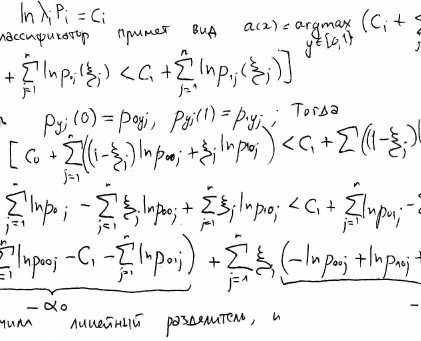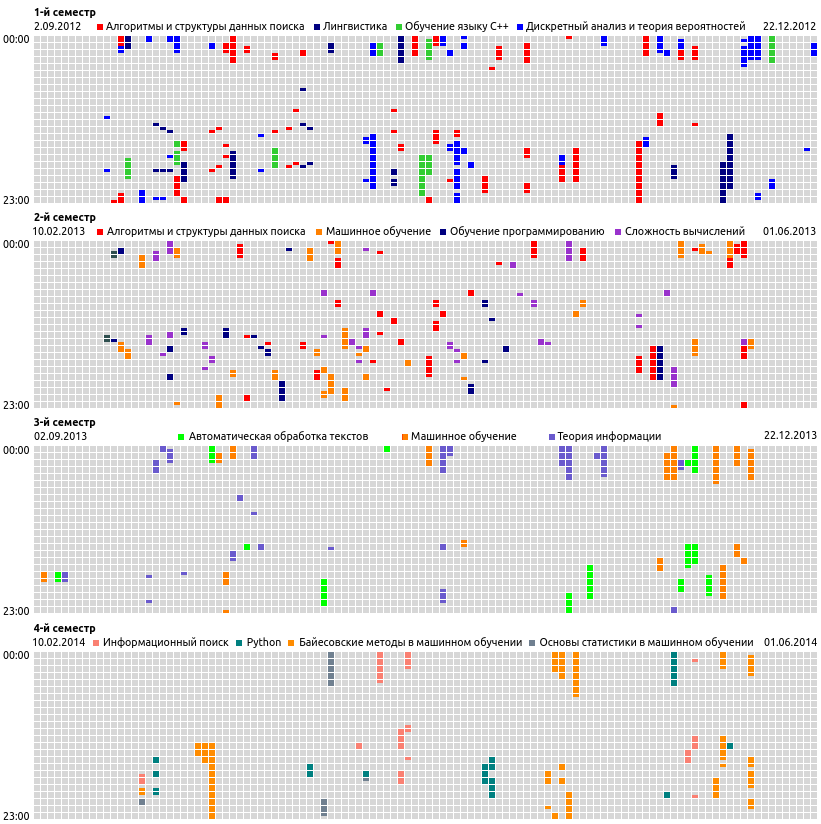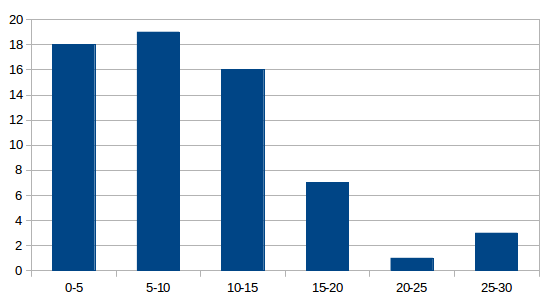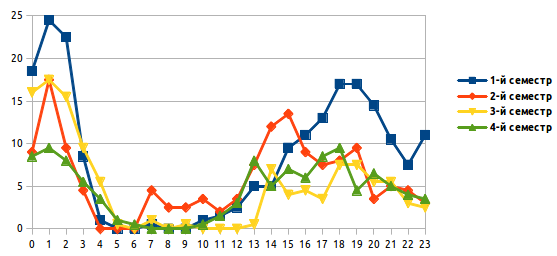Distance learning at ShAD Yandex: 570 wonderful hours of my life
 Two years ago, I was strongly impressed by the habrastia "Stephen Wolfram analyzed his life . " By that time, I had already been writing in the Google calendar for two years, what and when I did, but by that moment I did not think about what could be done with this information. After reading that article, I understood: this information can be analyzed! Now I can count how many times my friends and I were going to play basketball over the years, how many hours I spent in the hospital, etc.
Two years ago, I was strongly impressed by the habrastia "Stephen Wolfram analyzed his life . " By that time, I had already been writing in the Google calendar for two years, what and when I did, but by that moment I did not think about what could be done with this information. After reading that article, I understood: this information can be analyzed! Now I can count how many times my friends and I were going to play basketball over the years, how many hours I spent in the hospital, etc.This week I did my last homework at the ShAD and decided to calculate how much time it took me to study, how much I spent on average per week, how many lines of code I wrote, etc. I built several graphs and histograms, showed them to friends and understood That, perhaps, such information will be interesting to someone else. So, if you want to know how many report pages were written, how correct is the assessment of the load at the SAD at 15–20 hours per week , as well as my subjective opinion about the courses at the SAD, then welcome to Habrakat.
So, download the calendar with the information we are interested in, write a small script and get the following image.

Each block corresponds to a semester, each vertical strip of 24 cells in a block is a day, each cell is an hour in a day. The colors mark the time spent on a Shad course.
')
The first thing that catches the eye is that in the third and fourth semesters, I was lazy. It's true, you can translate everything into numbers and get the following table.
| Course name | Hours spent | Comment |
|---|---|---|
| Discrete analysis and probability theory | 63.5 | |
| Algorithms and search data structures | 73 | |
| Learning C ++ | 38 | |
| Linguistics | 27 | |
| 1st semester | 201.5 | |
| Algorithms and search data structures | 43.5 | |
| Programming training | 21 | |
| Machine learning | 45 | |
| Computational complexity | 30.5 | |
| Parallel and distributed computing | 2 | Did not pass |
| 2nd semester | 142 | |
| Machine learning | 43.5 | |
| Automatic text processing | 34.5 | |
| Information theory | 39 | |
| 3rd semester | 117 | |
| Python language | 21 | |
| Information Search | 21 | |
| Fundamentals of machine learning statistics | 9 | Did not pass |
| Bayesian methods in machine learning | 58 | |
| 4th semester | 109 | |
| Total | 569.5 |
It is immediately worth saying that there is some error in the data, since I recorded the clock with some rounding, as well as reading a book, say in Python, may not be taken into account here. Anyway, it turned out about 570 hours. Not so much, for example, in my application for the university diploma, I have written 8020 hours, but, as it seems to me, the watches at the SAD were used more efficiently.
I can also say that the complexity of the course correlates with the amount of time spent: “Algorithms and structures of search data” and “Discrete analysis and probability theory” seemed complicated to me, but the most complex course seemed to me to be “Bayesian methods in machine learning” I simply “sobbed” with this course, the last time I had the same feeling when I tried in my first year at university in N. Bourbaki's book “Lie groups and algebra” to understand the definition of a free groupoid. Nevertheless, what is important, on most subjects there was a good feedback from teachers, pointed out errors, said that it was possible to do better or redo it, which significantly improved the understanding of the subject.
But let's continue, check: is it true that I worked more on weekends than on weekdays, is it true that by the end of the semester and intermediate deadlines the amount of time spent increases.

Days of the week are plotted on the horizontal axis, and the number of hours on that day of the week spent on training in the SAD is set vertically.
In the first semester, when I worked on the usual five-day working week, it is noticeable that much had to be done on the weekend. In the second and third semesters, when I was writing my dissertation, everything was more or less uniform, the failure of the yellow line was associated with four pairs on the same day at the university. I can also explain the distribution of time in the fourth semester, but this explanation is not for habrastatis.
Also, remote learning is interesting because you can study anywhere, for example, I passed one of the homework on algorithms when I was traveling on the Novosibirsk-Omsk train, the other — when I was on a trolleybus to the university, or, for example, I wrote a python program at the airport , truth to deadline did not have time. Lectures can also be watched anywhere, I often recorded lectures on the phone and listened to them on the way to study or work. It's funny that even the three-story formulas from the lectures, which are written with a marker on the blackboard, I perceived by ear, but when watching the lectures, where all the material in presentations, I often had to look at the screen.

The horizontal axis shows the week number in the semester (or rather, the number of a seven-day segment), and the vertical axis indicates the number of hours spent this week.
It can be seen that in the first and second semester the number of hours spent before the end of the semester and before the intermediate deadline increase. There is no intermediate deadline in the third semester, but at the end of the semester, the time spent increases. About the fourth semester, I already wrote above. Although it would be more correct to do everything in advance, but somehow I once did one homework on information theory, in order to pass on time, on the night after defending the dissertation and related activities, I did it, I passed it, but he got the answer: “actually 0 divided by 3 ", how could I be so wrong - I do not understand! This case made me think about the need to somehow get rid of the habit of doing everything the night before the deadline.
If you divide 569.5 hours into 64 weeks, you get about 9 hours a week, but this number doesn’t mean much, the next histogram is much more informative.

On the horizontal axis - the intervals of time spent in hours, on the vertical - how many weeks fall into this interval.
It can be seen that there were 19 weeks in which I spent from 5 to 10 hours, 16 weeks in which I spent from 10 to 15 hours, 7 weeks in which I spent from 15 to 20 hours, there were also 4 weeks when it was spent 20 hours or more. In the remaining time, I did something less than 5 hours, but half of this time falls on the beginning and end of the semesters.
Finally, let's see how the elapsed time is distributed by the hour in days.

Hours in days are plotted on the horizontal axis, and how much time I spent on training at the SAD at this hour is plotted on the vertical axis.
The pits in the morning are quite consistent with the fact that I am sleeping at this time. Also, a small local maximum on the red line around 7 o'clock in the morning is explained by the fact that at that time I was driving to the first couple to the university and watched lectures in a trolley bus. Also, the fact that the highs fall at night indicates that I am an owl.
Let's calculate how many lines of code and report pages were written.
| 252 pages | |
| C ++ | 3139 lines |
| Python | 2187 lines |
| Java | 60 lines |
| R | 186 lines |
| Bash | 90 lines |
Of course, the code was not written very much, but I also had enough programming at work, so I didn’t perform some tasks. But 252 pages of reports and homework - this is serious, not sure that I have done so much at home at the university!
Now I will give answers to a few questions about the ShAD, which I often get asked.
- Is it difficult to enter the ShAD?
In my opinion, to do is simple. Preparation for admission took me 2 days, while I was traveling in the train Omsk – Moscow, I had with me a summary of the terver, which I looked through.
- Is it difficult to study at the ShAD?
It seemed to me difficult, but the point is not that you have to solve quite serious tasks, but that you need to be able to allocate your time so that you have enough time for everything: to study, to work, to SAD, to sports, to life . I did not manage to fully learn how to allocate the correct time. Therefore, it is better to study at university undergraduates or in the first 2 years of graduate school, when there is more free time. If you answer the question about studying at the ShAD, then the answer is: the complexity is quite comparable to the complexity of studying at the university, no super abilities are required.
- How much time to study at ShAD will be required?
As stated above, it took me about 570 hours to do this. But if you do all the homework and watch all the lectures and seminars, then you can easily navigate for 1000 hours.
- What did the training in shad give you?
First, I started programming C ++ much better and learned how to program in Python. Secondly, I understood machine learning from scratch, and also improved my knowledge of statistics. Thirdly, it became better to understand the data structures and algorithms. When I was interviewing for an internship at Yandex, I learned half of the answers to the questions asked at the ShAD. Fourthly, the knowledge gained from the courses “Discrete Analysis and Probability Theory”, “Information Theory”, “Computational Difficulty” helped me a lot in my postgraduate studies. Fifthly, while studying at the ShAD and during the internship at Yandex, I met several wonderful people.
- Where is the knowledge gained in the ShAD to apply?
If you only deal with, say, mobile application development, then perhaps knowledge of how to analyze data is not needed. But if the work is associated with data analysis or search, then the knowledge gained will be actively applied. Also courses on algorithms and data structures and programming languages will be useful in any case.
Source: https://habr.com/ru/post/277951/
All Articles